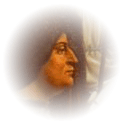Leonardo da Vinci (April 15, 1452 to May 2, 1519), the most extraordinary genius in every intellectual discipline - mathematics, music, anatomy, botany, architecture, military and civil engineering. In the five thousand pages of his notebooks, drawings notes, diagrams, sketches, studies etc., he recorded everything from the movement of the water to the mechanics of flight, from the study of light to the study of building and for the man which let him fly. But how does it started.
 Leonardo da Vinci was born in the hamlet of Vinci, near Florence. He was illegitimate son of a notary and a peasant woman.
He spent his youth exploring the Tuscan hills, staring in the stars and dreaming about flying, wandering through forest
and watching birds and animals that led to developing the interest in nature that would last through his life.
Leonardo da Vinci was born in the hamlet of Vinci, near Florence. He was illegitimate son of a notary and a peasant woman.
He spent his youth exploring the Tuscan hills, staring in the stars and dreaming about flying, wandering through forest
and watching birds and animals that led to developing the interest in nature that would last through his life.
His unusual talent was discovered very early. His drawing ability earned him an apprenticeship with the leading Florentine painter Andrea Verrocchio in 1466. His precious talent soon enabled him to surpass his master and so he got many commissions. It may have been that his interests in many disciplines kept him from completing commissions and gain him bad reputation for not finishing work. This probably prevented him from gaining a kind of permanent patronage - so important at his time. But Leonardo saw his creativity as a mirror of divine creation, a copy of the divine mind, since it operates freely in creating the many kind of various plants, animals, fruit, landscapes, country sides. In his "Treatise on Painting" he wrote "The artist has ideas first in his mind and then in his hands".
Leonardo's first major impact on Florentine art came with "Adoration of the Magi" which he left unfinished. This subject was particularly popular in contemporary Italy. His large (also unfinished) study, Leonardo began the painting from shaping his figures from the outset as structures of light and dark. Such innovative approach was new for the standard practice of painters at that time. They generally first set out a large design based on outlines, then filled them with standard elements from the collection of drawings stored in the workshop (for example hands, shoes, tunics, wings, even noses, etc.) and then to add volume and mass to their paintings they added areas of shading.
 In 1482 he went to Milan where he works for Ludovico Sforza mainly as military engeener. He spend a great deal of
time designing and building military defenses, however, many of his project have not been constructed and implemented.
He also found time to produce numerous entertaining inventions for his patron including theatrical stages,
spectacles and music as well as painting portraits of Ludovico's mistresses (Celicia Gallerani and Lucrezia Crivelli), frescos in his palace, and design fabric,
cloth and draperies so popular at his time.
In 1482 he went to Milan where he works for Ludovico Sforza mainly as military engeener. He spend a great deal of
time designing and building military defenses, however, many of his project have not been constructed and implemented.
He also found time to produce numerous entertaining inventions for his patron including theatrical stages,
spectacles and music as well as painting portraits of Ludovico's mistresses (Celicia Gallerani and Lucrezia Crivelli), frescos in his palace, and design fabric,
cloth and draperies so popular at his time.
 Celicia Gallerani's portrait by Leonardo, whom she described as "without equal" and in the
letter to Isabella d'Este Celicia modestly admit "the portrait shows me much younger and is no
longer a true likeness"
created a startling new ideal for courtly portrait. Celicia sits against a dark
background with wistfulness expression on her face, holding the ermine in her hand,
turning her face gracefully towards the left so that her face, throat, and the curve of
her shoulders are fully displayed. Her elegant hand with its long tapering fingers
caressing the sleek ermine is prominently rendered, bringing a new sensuality to the painting.
Her face is prepared to great long time waiting someone. She wears Spanish dress,
came just in fashion,
with long necklace made of black pearl. The portrait itself is full of hidden symbolic meanings.
The black pearl, this the most precious jewel, is used as a symbol of divine and earthly desire. The ermine,
because of the whiteness
of its fur is used as a symbol of purity and it was also Ludovico's il Moro favorite mascot. In this portrait
the artist is incorporating the observer into a production, buliding up tensiion in him without easing it.
In his couriosity, the observer is repeatedly referred back to the depicted woman. In Leonardo's words
a painting presented in such perfection would cause "lovers to speak to the portrait of the thing loved as if it were alive".
Celicia Gallerani's portrait by Leonardo, whom she described as "without equal" and in the
letter to Isabella d'Este Celicia modestly admit "the portrait shows me much younger and is no
longer a true likeness"
created a startling new ideal for courtly portrait. Celicia sits against a dark
background with wistfulness expression on her face, holding the ermine in her hand,
turning her face gracefully towards the left so that her face, throat, and the curve of
her shoulders are fully displayed. Her elegant hand with its long tapering fingers
caressing the sleek ermine is prominently rendered, bringing a new sensuality to the painting.
Her face is prepared to great long time waiting someone. She wears Spanish dress,
came just in fashion,
with long necklace made of black pearl. The portrait itself is full of hidden symbolic meanings.
The black pearl, this the most precious jewel, is used as a symbol of divine and earthly desire. The ermine,
because of the whiteness
of its fur is used as a symbol of purity and it was also Ludovico's il Moro favorite mascot. In this portrait
the artist is incorporating the observer into a production, buliding up tensiion in him without easing it.
In his couriosity, the observer is repeatedly referred back to the depicted woman. In Leonardo's words
a painting presented in such perfection would cause "lovers to speak to the portrait of the thing loved as if it were alive".
The charming and vivid impression Cecilia makes gained Leonardo the reputation of
beeing talented portrait painter. Future generatons of painters and his contemporaries admired
his new style in female
portraiture and several attempts have been made to counterfeit his unusual style (Raphael Santi,
Giulio Romano, and others).
As not signed the portrait for may years was not recognized as Leonardo's masterpiece.
In early years of XIX century it was
bought as a Souvenir on the Italian market by prince Adam Czartoryski for incredibly low price.
He gave it to his mother as a present. Princess Izabella Czartoryska commented it in her Diary:
"It was given to me by my
son who had brought it from Italy. [...] The little animal held in the arms of the young woman is
hard to describe.
If it is a dog it is certainly ugly one. It could be another animal but I could not say which."
At the end of her life Izabella Czartoryska hanged Celicia's portrait it in her pink room of her palace in Krakow (Poland)
where it can be seen today. During Izabella's art disputes it began to attract the attention of
critics and art experts.
It is possible that this portrait which express extraordinary effect of the facial similarity of the woman
to the animal with two mentioned above well readable symbols is alluding Ludovico il Moro
himself as commissioner,
and Leonardo da Vinci as a painter.
After two centuries of doubts, uncertainties and comparisons it is certain that
this masterpiece was made by Leonardo da Vinci. Cecilia Gallerani will appear on Leonardo's paintings once more ,
this time as Archangel Uriel in "Madonna of the Rocks" (Louvre, Paris) and slightly modified version "Virgin of the Rocks"
(National Gallery of Art, London, UK).
(There is another version of the painting dated to around 1508 in a private collection.)
His later portraits such as Mona Lisa injected a great sense of personality and psychological complexity into portraiture. Leonardo's portraits of women are especially appealing for their mystery and ultimate elusiveness.
In his paintings he successfully combined old and new painting techniques. His meditations on paintings, experiments with new variations of old and new techniques as he went along he noted in Treatsy on Painting, which is a lot more than technical manual. About benefits from implementation new techniques called sfumato (smoky shadows) and scuro-chiaro (contrast of light and dark). About scuro-chiaro technique he wrote in these words: "the utmost grace in the shadows and the lights is added to the faces of those who sit in the darkened doorways of their dwellings. Then the eye of the beholder observes the shaded part of the face thrown into deeper shade by the shadows from the aforesaid dwellings, and see brightness added to the illuminated part of the face by the radiance of the atmosphere. Because of such increases in the shadows and lights the face acquires great relief, and in the illuminated part the shadows are almost indistinguishable, and in the shaded part the lights are almost indistinguishable. The face depicted in this way acquires much beauty with the increase in shadows and lights." (see "Treatise on painting", Chapter 93). However, about sfumato (smoky shadows) he expressed himself as: " those faces which have the planes joined in such a way that they take shades and lights agreeably and pleasantly, and have no harshness of the relief angels, these we should certainly say are beautiful and delicate faces". (See "Treatise on painting", Chapter 2) (He had very poetical language, indeed.)
Leonardo's the most famous painting, however, is the Last Supper (Milan) where he used a novel fresco technique, but the medium an experimental variation of the this technique not lasted long and fast deteriorated. The Last supper is also the traditional subject particularly popular for refectories, where monks gathered to have their meals, and hear reading of Gospels. Christ was always shown at the center of the table with the apostles divided into three groups on his sides, apart from Judas who was traditionally isolated across the table.
In Last Supper Leonardo maintained the traditional format of the painting, apart from a small detail that John, who is sitting on the left side of the Christ somehow resembles a woman. Inconsistently to the old convention, he does not treat apostles as individuals. He consolidates them into 3 groups. Each expression and gesture on the painting has been carefully studied, used every symbol was carefully selected to bring very clear but sometimes carefully hidden meaning to the story.
List of Leonardo Works and Portraits:
| Works | Portraits |
|---|---|
| 1469-1482: white, transparent dog in the corner of "Tobias and the Angel" by Verrocchio, landscape and angel in "Baptism of Christ" by Verrocchio Annunciation Benois Madonna Adoration of the Magi and St. Jerome. |
1469-1482: portrait of Ginevra de Benci drawing "The hanged Bernardo di Bandino Baroncelli" portrait of Lucrezia Donati "Lady with the beautiful hands" |
| 1483-1499: First version "Virgin of the Rocks" studies and the model for the monument to Francesco Sforza studies and the model for the lantern of Milan cathedral Last Supper "Salla delle Asse" in the Sforza Castle |
1483-1499: portrait of Cecilia Gallerani - "Lady with an Ermine" "The Musician" portrait of Franchimo Gaffurio (Josquin des Pres?) portrait of Lucrezia Crivelli - "La Belle Ferroniere" |
| 1500-1500: "Madonna of the Yarnwinder" first cartoon for "St. Anne" "Battle of Anghiari" second version "Virgin of the Rock" architectural and theatrical sets in Milan project of the monument to Gian Giacomo Trivulzio project for Adda canal system from Lecco to Milan, still in use |
1500-1500: portrait of Isabella d'Este portrait of Scaramuccia - never finished portrait of Giambullari House in Florence portrait of Mona Lisa portrait of unknown girl called "La Scapiliata |
| 1511-1519: project for draining the Pontine marshes project for new palace for Medici in Florence mechanical lion project of the royal palace at Romorantin canal system for Sologne |
1511-1519: portrait of little boy portrait of "certain Florentine lady" building new studio in France |